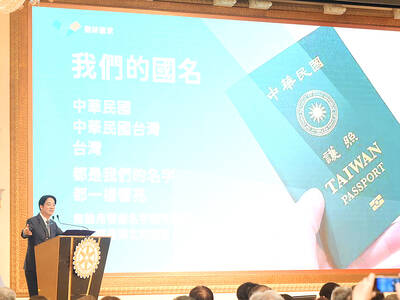In a move that risks increasing regional tensions, China yesterday announced it will invest more than 10 billion yuan (US$1.6 billion) to build infrastructure on disputed islands in the South China Sea and to strengthen marine law enforcement in the region.
Citing Hainan Province Governor Jiang Dingzhi (蔣定之), the Guangzhou-based 21st Century Herald reported that China would build an airport, piers and other important infrastructure on islands administered by Sansha (三沙), a prefecture-level city under Hainan’s jurisdiction that was created in July following approval by the State Council in June.
Located on Woody Island (Yongxing Island, 永興島), the largest island in the Paracels (Xisha Islands, 西沙群島) and 350km southeast of Hainan, Sansha “administers” more than 200 islets, sandbanks and reefs and their surrounding waters in the Spratly Islands (Nansha Islands, 南沙群島), Macclesfield Bank (Zhongsha Islands, 中沙群島) and the Paracel chains.

Photo: AFP
Some of the construction has already begun, the paper said, without providing details.
The Industrial and Commercial Administration Bureau of Hainan Province announced in September that the establishment of Sansha had caught the attention of investors, with the bureau receiving “multiple queries” about setting up businesses in Sansha.
A construction company and a tourism investment company received approval in August and September respectively, Chinese media said.
According to a report in Caijing magazine, officials in Sansha have been evaluating various commercial development plans, including the establishment of a tax haven and casino resorts.
While serving to create facts on the ground to bolster China’s sovereignty claims in the South China Sea, the investment projects have been a source of tension with other claimants, forcing Beijing to add a security component to the project.
In July, China’s Central Military Commission approved the creation of a military garrison on Sansha.
Taiwan, Vietnam, the Philippines, Malaysia and Brunei also have claims to some of the islets. Itu Aba Island (Taiping Island, 太平島), the largest islet in the Spratlys, is controlled by Taiwan.
According to the Herald, Jiang added that in addition to supporting infrastructure, the funds would be used to acquire marine law enforcement vessels and supply ships.
Under new rules announced last month and which are to come into effect on Tuesday next week, police in Hainan will have the authority to board and seize control of foreign ships that “illegally” enter Chinese waters. It remains unclear whether the directive only pertains to coastal areas near Hainan Island or to the entire body of water administered by Sansha.
Chinese media reported at the time that the government would also send new maritime surveillance ships to supplement the fleet responsible for patrolling the South China Sea.
Additional reporting by Bloomberg

LONG FLIGHT: The jets would be flown by US pilots, with Taiwanese copilots in the two-seat F-16D variant to help familiarize them with the aircraft, the source said The US is expected to fly 10 Lockheed Martin F-16C/D Block 70/72 jets to Taiwan over the coming months to fulfill a long-awaited order of 66 aircraft, a defense official said yesterday. Word that the first batch of the jets would be delivered soon was welcome news to Taiwan, which has become concerned about delays in the delivery of US arms amid rising military tensions with China. Speaking on condition of anonymity, the official said the initial tranche of the nation’s F-16s are rolling off assembly lines in the US and would be flown under their own power to Taiwan by way

OBJECTS AT SEA: Satellites with synthetic-aperture radar could aid in the detection of small Chinese boats attempting to illegally enter Taiwan, the space agency head said Taiwan aims to send the nation’s first low Earth orbit (LEO) satellite into space in 2027, while the first Formosat-8 and Formosat-9 spacecraft are to be launched in October and 2028 respectively, the National Science and Technology Council said yesterday. The council laid out its space development plan in a report reviewed by members of the legislature’s Education and Culture Committee. Six LEO satellites would be produced in the initial phase, with the first one, the B5G-1A, scheduled to be launched in 2027, the council said in the report. Regarding the second satellite, the B5G-1B, the government plans to work with private contractors

‘OF COURSE A COUNTRY’: The president outlined that Taiwan has all the necessary features of a nation, including citizens, land, government and sovereignty President William Lai (賴清德) discussed the meaning of “nation” during a speech in New Taipei City last night, emphasizing that Taiwan is a country as he condemned China’s misinterpretation of UN Resolution 2758. The speech was the first in a series of 10 that Lai is scheduled to give across Taiwan. It is the responsibility of Taiwanese citizens to stand united to defend their national sovereignty, democracy, liberty, way of life and the future of the next generation, Lai said. This is the most important legacy the people of this era could pass on to future generations, he said. Lai went on to discuss

MISSION: The Indo-Pacific region is ‘the priority theater,’ where the task of deterrence extends across the entire region, including Taiwan, the US Pacific Fleet commander said The US Navy’s “mission of deterrence” in the Indo-Pacific theater applies to Taiwan, Pacific Fleet Commander Admiral Stephen Koehler told the South China Sea Conference on Tuesday. The conference, organized by the Center for Strategic and International Studies (CSIS), is an international platform for senior officials and experts from countries with security interests in the region. “The Pacific Fleet’s mission is to deter aggression across the Western Pacific, together with our allies and partners, and to prevail in combat if necessary, Koehler said in the event’s keynote speech. “That mission of deterrence applies regionwide — including the South China Sea and Taiwan,” he